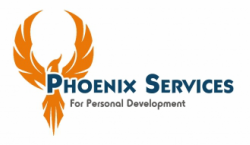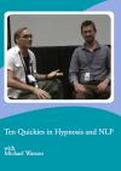Part Five in a series by Michael Watson
This is the fifth installment in our discussion about the essential attitudes of NLP. So far we’ve considered the uniqueness of individuals, and how they create experience. We’ve looked at the positive intentions behind people’s behavior, and the importance of the power of choice.
And because people DO have choice – whether they know it or not – the question becomes how to make those choices available and apply them to make a difference in their lives.
So when you’re trying to expand possibilities and open up more choice, the thing to bear in mind is this next presupposition
PEOPLE HAVE ALL THE RESOURCES THEY NEED
And I know that it often doesn’t seem to be the case. Because the problem is, they don’t always have access to these resources when they need them. For example, a timid (and therefore unsuccessful) salesman came to see me and said that he needed to “have more courage, take more chances, stop hesitating and be more proactive.” All qualities that he felt he was missing. Yet just a couple weeks before he’d come to see me, he was a HERO at a lakeside park when he bravely and without hesitation dove into ice cold water and rescued a little girl who had fallen in. Every one of the qualities he wanted in his sales work, he’d already displayed in another context.
And when someone comes to the conclusion that a particular quality is desirable and would help them in a given situation, how did they come to that conclusion? They already had a built-in representation of that quality or state.
Christina Hall, one of the unsung (in the US) co-creators of NLP has suggested that this presupposition isn’t true only when it means that a person has that resource in their history. It’s true because that person has a human neurology … and that’s the requirement … all the needed resources can be created in the mind, translated into experience, and brought into real-life situations.
Now when we’ve learned to do that … and begin making those changes, we just might discover that the resources we chose weren’t the best ones. And just like raising children, developing and cultivating a garden, driving across the country through uncharted territory or sending a spaceship to the moon, you pay close attention to how it’s working and you keep making adjustments until you get it right. And that’s what’s behind the next presupposition.
THERE IS NO SUCH THINGS AS FAILURE; ONLY FEEDBACK
What a relief THAT is! When we learn to pay attention to what’s working and what’s not working, and use that information to adjust what we’re doing, and keep at it till we get there - this is the meaning of T.O.T.E.
Test à Operate à Test à Exit
We notice the current state of affairs (test 1) … we take some action to change it (operate ) … we notice how things are now (test 2) … and we continue operating and testing and operating and testing … until the test is “successful” – it’s produced the result we were going for. And then we’re done. (Exit, stage right).
Failure is success that stopped too soon, they say. You haven’t failed if you’re still going for it. And even if you stop going for it, if it gave you some useful feedback – if you learned something you can apply later – you’ve succeeded at THAT.
There’s an expression in the NLP community that I’ve found very helpful, and that can be very encouraging when you’re working with some challenging areas of your life.
“Anything worth doing is worth doing badly at first.”
Consider this. (From my good friend Jamie Smart) When you were a little baby, you didn’t know anything about walking. You may have pulled yourself up by the edge of the sofa or something … and stood for a moment or two, before you came crashing down. And eventually you took a step … and likely fell on your behind. And I’ll bet that happened several times. And you never failed … because you never just sat down on the floor and decided, “Well, I guess I’m just not a walker!” Because it was important enough that you kept at it - worth doing badly at first – until you got it down.
Now I can understand why some people get frustrated and quit … especially if they don’t know have the next essential attitude.
THERE’S A SOLUTION TO EVERY PROBLEM
It’s hard to keep on going if you don’t think the problem can ever be solved or the challenge can ever be met, or the dream can ever be realized. But it’s really worthwhile, especially if you’re a coach or therapist, to start out with the understanding that whatever it is, there is a solution. And if you do work with others, it would certainly be unscrupulous for you to collect fees from them if you didn’t believe that their issues could be resolved. In fact, one fo the greatest services we can do for others is to hold the space that allows for and in fact INSISTS on the possibility that they can get what they want. That they can achieve their goals. Optimistic? Perhaps. Encouraging? You bet!
So now that we’ve talked about the resources you have, the importance of using feedback, and the value of making adjustments and persisting until you achieve the results you want; there’s another presupposition that might help. It’s known more formally as “The Law of Requisite Variety” but what it boils down to is:
THE ELEMENT IN A SYSTEM WITH THE MOST FLEXIBILITY WILL BE THE CONTROLLING ELEMENT IN THAT SYSTEM.
When we can learn to vary our behavior as much and as often as necessary, we have much more control than when our attitude is rigid and we only see one way to do things. Creativity comes from thinking outside of the box … and that’s usually where the solutions lie. The ability to achieve includes and requires the ability to do things “every which way” … to keep making those adjustments we were talking about earlier. And flexibility is the key to success.
Next time we’ll be wrapping up this series with a couple really important attitudes about communication. If you have trouble getting your message across, or making sense out of some of the people in your life, this just might help. So ‘til then remember to practice flexibility, get feedback, use all resources you can summon up … and there won’t be any problem that you can’t solve. Say good bye to failure, and keep on keeping on.
This is the fifth installment in our discussion about the essential attitudes of NLP. So far we’ve considered the uniqueness of individuals, and how they create experience. We’ve looked at the positive intentions behind people’s behavior, and the importance of the power of choice.
And because people DO have choice – whether they know it or not – the question becomes how to make those choices available and apply them to make a difference in their lives.
So when you’re trying to expand possibilities and open up more choice, the thing to bear in mind is this next presupposition
PEOPLE HAVE ALL THE RESOURCES THEY NEED
And I know that it often doesn’t seem to be the case. Because the problem is, they don’t always have access to these resources when they need them. For example, a timid (and therefore unsuccessful) salesman came to see me and said that he needed to “have more courage, take more chances, stop hesitating and be more proactive.” All qualities that he felt he was missing. Yet just a couple weeks before he’d come to see me, he was a HERO at a lakeside park when he bravely and without hesitation dove into ice cold water and rescued a little girl who had fallen in. Every one of the qualities he wanted in his sales work, he’d already displayed in another context.
And when someone comes to the conclusion that a particular quality is desirable and would help them in a given situation, how did they come to that conclusion? They already had a built-in representation of that quality or state.
Christina Hall, one of the unsung (in the US) co-creators of NLP has suggested that this presupposition isn’t true only when it means that a person has that resource in their history. It’s true because that person has a human neurology … and that’s the requirement … all the needed resources can be created in the mind, translated into experience, and brought into real-life situations.
Now when we’ve learned to do that … and begin making those changes, we just might discover that the resources we chose weren’t the best ones. And just like raising children, developing and cultivating a garden, driving across the country through uncharted territory or sending a spaceship to the moon, you pay close attention to how it’s working and you keep making adjustments until you get it right. And that’s what’s behind the next presupposition.
THERE IS NO SUCH THINGS AS FAILURE; ONLY FEEDBACK
What a relief THAT is! When we learn to pay attention to what’s working and what’s not working, and use that information to adjust what we’re doing, and keep at it till we get there - this is the meaning of T.O.T.E.
Test à Operate à Test à Exit
We notice the current state of affairs (test 1) … we take some action to change it (operate ) … we notice how things are now (test 2) … and we continue operating and testing and operating and testing … until the test is “successful” – it’s produced the result we were going for. And then we’re done. (Exit, stage right).
Failure is success that stopped too soon, they say. You haven’t failed if you’re still going for it. And even if you stop going for it, if it gave you some useful feedback – if you learned something you can apply later – you’ve succeeded at THAT.
There’s an expression in the NLP community that I’ve found very helpful, and that can be very encouraging when you’re working with some challenging areas of your life.
“Anything worth doing is worth doing badly at first.”
Consider this. (From my good friend Jamie Smart) When you were a little baby, you didn’t know anything about walking. You may have pulled yourself up by the edge of the sofa or something … and stood for a moment or two, before you came crashing down. And eventually you took a step … and likely fell on your behind. And I’ll bet that happened several times. And you never failed … because you never just sat down on the floor and decided, “Well, I guess I’m just not a walker!” Because it was important enough that you kept at it - worth doing badly at first – until you got it down.
Now I can understand why some people get frustrated and quit … especially if they don’t know have the next essential attitude.
THERE’S A SOLUTION TO EVERY PROBLEM
It’s hard to keep on going if you don’t think the problem can ever be solved or the challenge can ever be met, or the dream can ever be realized. But it’s really worthwhile, especially if you’re a coach or therapist, to start out with the understanding that whatever it is, there is a solution. And if you do work with others, it would certainly be unscrupulous for you to collect fees from them if you didn’t believe that their issues could be resolved. In fact, one fo the greatest services we can do for others is to hold the space that allows for and in fact INSISTS on the possibility that they can get what they want. That they can achieve their goals. Optimistic? Perhaps. Encouraging? You bet!
So now that we’ve talked about the resources you have, the importance of using feedback, and the value of making adjustments and persisting until you achieve the results you want; there’s another presupposition that might help. It’s known more formally as “The Law of Requisite Variety” but what it boils down to is:
THE ELEMENT IN A SYSTEM WITH THE MOST FLEXIBILITY WILL BE THE CONTROLLING ELEMENT IN THAT SYSTEM.
When we can learn to vary our behavior as much and as often as necessary, we have much more control than when our attitude is rigid and we only see one way to do things. Creativity comes from thinking outside of the box … and that’s usually where the solutions lie. The ability to achieve includes and requires the ability to do things “every which way” … to keep making those adjustments we were talking about earlier. And flexibility is the key to success.
Next time we’ll be wrapping up this series with a couple really important attitudes about communication. If you have trouble getting your message across, or making sense out of some of the people in your life, this just might help. So ‘til then remember to practice flexibility, get feedback, use all resources you can summon up … and there won’t be any problem that you can’t solve. Say good bye to failure, and keep on keeping on.




 RSS Feed
RSS Feed
